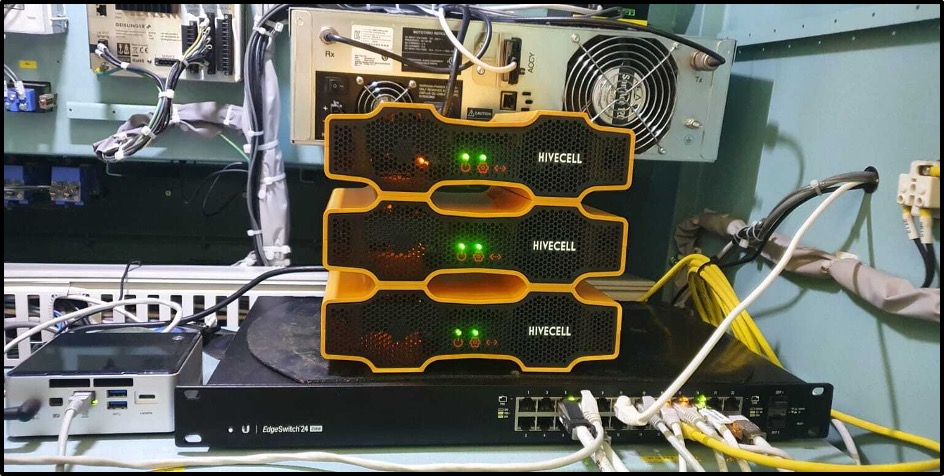Characteristics of the edge
Edge is not a data center. Here are six key characteristics of edge environments:
- No data closet
- No technical staff on site
- Hundreds or thousands of locations
- Limited or intermittent network bandwidth
- Behind someone else’s firewall
- Demand for compute power always increasing
For some of you, this will be validation. You are not alone. Many others face the same challenges. For others, such as IT professionals who have spent their career in the data center, this will be eye opening.
No data closet
As mentioned earlier, industry is using the term “edge” rather loosely. Some call regional data centers “near edge”. Edgecell is focused on “far edge” or real edge computing. So the first characteristic of an edge computing environment is: there is no data closet. Even if there is a data closet, it was full, underpowered and overheating long ago. There is no room for more servers.

The photo above is a typical edge deployment environment. It is the engine room of a cargo ship. You will see pretty much the same thing on a factory floor, in a job trailer, in a quick service restaurant, a retail store, a warehouse, a clinic, etc. In other words, the real edge.
There is no uninterrupted power supply (UPS), no top of rack router. Sometimes there is no air conditioning. This is not the sort of place you put a $20,000 server.
No technical staff
Second characteristic of edge: there is no technical staff. For the IT department working in the data center, this is hard to grasp. You see, they operate in a centralized controlled environment surrounded by their peers. They know how to shell into a server, configure a network routing table. Doesn’t everybody? No, they don’t. The most basic knowledge in a data center, the stuff the summer intern should know, is rocket science to anyone else. So how things get done, get installed and deployed in the data center is just not going to work at the edge.
Hundreds or thousands of locations
Third characteristic of the edge: there are hundreds or thousands of locations. Some customers have tens of thousands of locations. A DEVOPS guy, someone who manages deploying enterprise applications, he used to a handful of deployment locations. There is a DEV environment that the programmers use. There are UAT and STAGE environments for testing. There may be regional production environments, but all total? You can count them on your hands.
A simple manual process is feasible in the data center. It takes five minutes, no big deal. With edge, however, that five minutes for 1,000 locations becomes 5,000 minutes. That’s 83 hours. That’s more than 10 working days. That’s a big deal.
It is the difference between pets and cattle. Traditional enterprise software has pet servers. You name your pets. You know when they ate, what they ate. Edge computing is a herd of cows. They don’t have names, they have tags. You feed them in mass.
We will discuss more about edge scale later.
Limited or intermittent network
The fourth characteristic of edge computing: limited or intermittent network connectivity and bandwidth.
In one deployment of Edgecell, the customer had a remote cluster connected to the Internet through a satellite modem. Someone parked a piece of heavy equipment that blocked the line of sight to the satellite for six days. Retail stores do not have such an extreme situation, but local outages are a reality. Large storms and even construction accidents can knock out communications for hours or even days.
Management systems for data centers do not anticipate limited or intermittent network connectivity. Some systems expect 20 GB connections between servers. That is a ridiculous expectation at the edge.
Behind someone else’s firewall
Data center management systems such as VMware VCenter make a simple assumption: the management software is behind the same firewall as the servers it is managing. This assumption is perfectly logical for a data center. It can be made to work for virtual private clouds (VPC). However, it is completely illogical for the edge.
These systems require dozens of ports be open to connect and administer the server. Creating such a large hole in a firewall is unacceptable. Creating, maintaining and monitoring the required holes in hundreds or thousands of locations would be a huge undertaking. Read: expensive.
In reality, however, it is impossible task, because quite often in edge deployments, you have no control over the firewall. Someone else owns it. For instance, for franchised retail, the franchiser wants to deploy edge computing in each store but the various franchisees own the network and firewall of those stores.
Demand for compute power is always increasing
The last notable characteristic is that the demand for edge compute power at the current moment is relatively small. Once deployed, however, the demand will increase continuously. There will be another application, and another and another. New unanticipated use cases will follow one after another. The data will grow and grow. There will be more smart devices, more machine learning models, more everything.
When planning edge computing, customers need to consider how they will incrementally increase their edge infrastructure. The cost of the initial deployment is just the beginning. Edge infrastructure will need to start small and scale quickly.